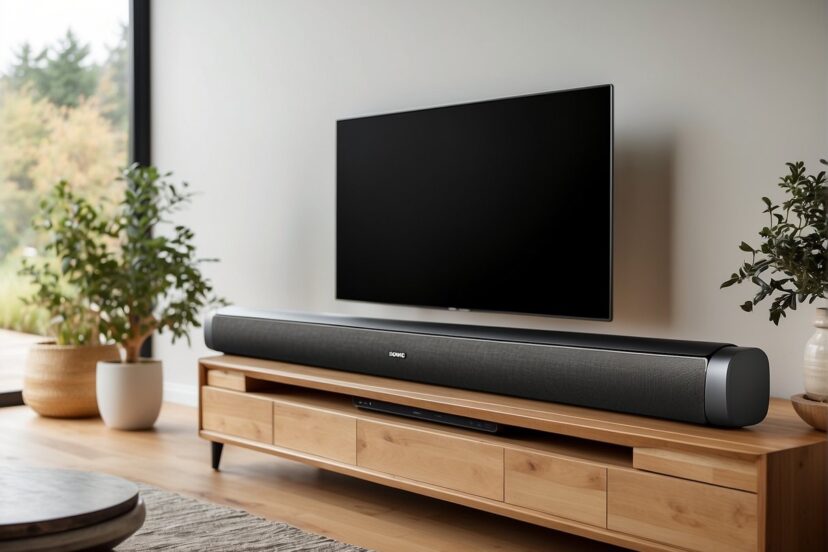Sonos Arc vs Beam: Comparing Premium Soundbars
*We may earn a commission for purchases made using our links. Please see our disclosure to learn more.
Sonos Arc vs Beam: Comparing Premium Soundbars for Home Audio Excellence
The ultimate showdown Sonos Arc vs Beam! When considering premium soundbars, the Sonos Arc and Sonos Beam are two of the most discussed options in today’s market. Their popularity stems from Sonos’ reputation for producing high-quality audio devices with sleek designs that integrate well into various home setups. As someone who values precision in sound and aesthetic integration, I find the distinctions between these models to be integral for potential buyers to understand.

The Sonos Arc stands out with its impressive size and the inclusion of features like Dolby Atmos support, making it an ideal choice for larger rooms where a full, immersive audio experience is desired. It boasts a wider design, which not only affects its placement options but also contributes to its capability for enveloping sound. The Beam, on the other hand, appeals to those who may have less space or prefer a more compact sound system. It is smaller in stature but still delivers high-quality audio that Sonos users have come to expect.
While the Arc could be considered the more full-featured offering of the two, it is typically the higher-priced option, and its specs reflect this. The Beam serves as a more affordable alternative without forgoing the essential experience of a quality soundbar. Ultimately, my observation is that the choice between the Arc and the Beam will depend on one’s individual needs, taking into account room size, budget, and desired features.
Sonos Arc vs Beam: Overview of Sonos Soundbars
In my examination of the Sonos soundbar lineup, I’ll focus on their flagship models, the Sonos Beam and Sonos Arc, each tailored to different user needs. These soundbars are recognized for their sound quality and smart capabilities.
Sonos Beam
The Sonos Beam is a compact soundbar designed to fit the aesthetics and audio requirements of small to medium-sized rooms. My observation is that the Beam blends seamlessly with TV setups starting at 32 inches and upwards, providing significant sound enhancements in tight spaces. It’s worth mentioning that the Sonos Beam (Gen 2) supports a HDMI eARC connection, marking it as a device suitable for modern TVs that prioritize audio-visual synchronization.
| Feature | Sonos Beam (Gen 2) |
| Dimensions | Suitable for 32-inch and larger TVs |
| Connection | HDMI eARC support |
Sonos Arc
Conversely, the Sonos Arc caters to users seeking a more powerful soundstage suitable for large rooms and clientele who may use bigger TVs, starting from 55 inches and more—a robust option for an immersive audio experience, especially when paired with Dolby Atmos content. The Arc is distinct in its size, being wider than the Beam, and is priced higher. Its design is sophisticated, featuring a perforated grille that covers the length of the unit.
Both soundbars can be integrated into the wider Sonos ecosystem, merging multi-room audio features with the convenience of smart home integration.
| Feature | Sonos Arc |
| Dimensions | Best with 55-inch TV or larger |
| Sound Technology | Dolby Atmos support |
Design and Build Quality

In comparing the Sonos Arc and the Beam, their design and build quality stand out as significant factors. I will discuss the materials and aesthetics as well as the considerations of placement and size in relation to these soundbars.
Materials and Aesthetics
The Sonos Arc boasts a premium design with a seamless elliptical shape that complements modern interiors. I find its perforated polycarbonate grille not only functional for acoustic transparency but also contributes to its elegant appearance. Available in black or white, the Arc seamlessly blends with a variety of home decors.
In contrast, the Sonos Beam has a more compact and versatile aesthetic, with similar build quality but tailored for smaller spaces. With its sleek design, the Beam is discreet and unobtrusive, also offering black and white options to match its surroundings.
Placement and Size
When it comes to placement and size, the Sonos Arc is clearly the larger of the two. Measuring 45 inches in width, it’s more suited for larger TVs, optimally 55 inches and above. Its size requires more space but is justified by its powerful performance capabilities, including the utilization of elliptical woofers for richer sound. Wall mounting the Arc is an option, although a separate bracket purchase is necessary.
The Beam, on the other hand, is much more accommodating for various room sizes. It’s notably smaller, making it a perfect fit for smaller rooms or TV setups around 32 inches to 40 inches. The Beam’s compact size can be a significant advantage if you’re working with limited space and still seeking quality sound. Wall mounting is also available for the Beam, granting additional flexibility in placement within the home.
Sound Quality and Performance

In considering the Sonos Arc and Beam, I’ll focus on the advanced audio technologies they harbor and the distinctive listening experiences they offer.
Audio Technologies
Sonos Arc and Beam soundbars integrate various audio technologies to enhance sound quality. The Sonos Arc features Dolby Atmos, which adds a sense of verticality to audio, providing a more immersive experience. It utilizes an array of drivers, including up-firing speakers, to reflect sound off the ceiling to create that three-dimensional effect. With more drivers and passive radiators, the Arc offers a broader, more dynamic soundstage. In terms of connectivity, it supports enhanced Audio Return Channel (eARC), allowing high-quality audio transmission from TV to soundbar.
The Sonos Beam (Gen 2), while more compact, also supports Dolby Atmos via its five drivers, though it lacks the up-firing components. The Beam houses a combination of tweeters and woofers to ensure a clear and balanced sound. Its smaller form factor means it may not fill a room as expansively as the Arc, but it is still capable of providing a dynamic audio reproduction.
- Sonos Arc:
- Dolby Atmos support
- eARC compatibility
- Array of drivers including tweeters, and woofers
- Up-firing speakers for 3D sound
- Sonos Beam (Gen 2):
- Dolby Atmos support (without up-firing speakers)
- eARC compatibility
- Five-driver configuration
Listening Experience
My analysis of their listening experience reveals that the Sonos Arc is designed for those seeking a full home cinema experience. It performs exceptionally well by delivering cinematic, spacious sound that enhances both music playback and movie watching. With Dolby Atmos, the Arc creates an engaging listening environment, particularly noted for its capacity to make dialogue stand out clearly amidst high-impact scenes.
Conversely, the Sonos Beam delivers an impressive sound for its size. It might not reach the voluminous sound scope of the Arc, but it maintains a clear and dynamic audio quality that benefits all forms of content. The dialogue remains distinct and forward, which is ideal for TV shows and news programs, ensuring that every word is heard with clarity.
- Sonos Arc:
- Impressive, room-filling audio presence
- Enhanced dialogue clarity
- Dynamic and detailed soundstage
- Sonos Beam (Gen 2):
- Clear, balanced audio for its size
- Good dialogue presence
- Dynamic and full, despite a smaller soundstage
Features and Connectivity

In comparing the Sonos Beam Gen 2 and the Sonos Arc, I find it crucial to examine both the features they offer and the types of connectivity supported. Each device caters to different needs, with the Arc offering a more expansive sound for larger spaces and the Beam being a more compact option.
Smart Home Integration
Sonos Arc:
- Voice Control: Integrated with Amazon Alexa and Google Assistant for easy voice commands.
- AirPlay 2: Allows streaming directly from Apple devices and integration into a wider Apple ecosystem.
Sonos Beam Gen 2:
- Voice Assistant: Also equipped with Amazon Alexa and Google Assistant.
- AirPlay 2 Compatibility: Supports Apple AirPlay 2 for streaming audio from compatible devices.
Streaming and Support
Sonos Arc:
- Connections: Equipped with HDMI eARC for high-quality sound and easy connection to TVs.
- Streaming: Can stream music from services like Spotify directly through the Sonos app, which also supports multi-room audio setups.
- Sonos Sub: Can pair with the Sonos Sub and other Sonos speakers for a more immersive multi-room system.
Sonos Beam Gen 2:
- HDMI : Features an HDMI connection, though not eARC like the Arc.
- Wi-Fi Streaming: Offers Wi-Fi connectivity for streaming and supports the Sonos app’s Trueplay feature, which optimizes sound for the room it’s in.
- Multi-Room: Like the Arc, it supports multi-room audio, allowing for a spacious sound experience in any room.
Pricing and Value

When comparing the Sonos Beam and Sonos Arc, it’s essential to consider their price points alongside the value they offer. I’ll explore both immediate budget implications and the long-term value to guide your purchase decision effectively.
Budget Considerations for Sonos Arc vs Beam
The Sonos Arc, being the more premium model, offers advanced features such as Dolby Atmos support, a larger soundstage, and more speakers for a fuller, more immersive audio experience. This makes it an ideal choice for larger rooms or for users who prioritize high-quality audio for movies, music, and gaming. The investment in the Arc reflects its positioning as a high-end home theater component.
On the other hand, the Sonos Beam is a more compact soundbar that offers excellent sound quality and smart features at a more accessible price point. It is well-suited for smaller spaces or for those who have a more modest budget but still want a quality sound experience with smart capabilities. The Beam’s cost-effectiveness makes it an attractive option for users looking to upgrade their home audio system without stretching their finances too much.
You, as a buyer, may find significant price variations during promotional periods or depending on the retailer. Therefore, it is worth searching for deals or discounts that may align with your budget.
Upgrade and Long-Term Value
When considering an upgrade, the Sonos Arc presents a more powerful option with advanced features like enhanced Dolby Atmos support, making it a worthwhile long-term investment if your budget allows. In contrast, the Beam offers considerable value with an expansive soundstage and robust features at a lower price point, which is nearly half that of the Arc. The choice between the two might depend on personal criteria such as room size, desired audio quality, and existing home theater setup.
- Sonos Beam: Good value for money, suitable for smaller rooms or budgets.
- Sonos Arc: Premium offering with advanced audio technology, ideal as a long-term investment.
Compatibility and Ecosystem of Sonos Arc vs Beam
When considering a soundbar like the Sonos Beam or Sonos Arc, it’s important to understand how each device integrates with your current home cinema setup and what expansion options are available.
Integration with Existing Systems
I find that the Sonos Arc and Beam both excel at integrating into an existing Sonos ecosystem. Each one offers seamless compatibility with other Sonos speakers, facilitating the creation of a comprehensive surround sound experience. These soundbars connect to the home WiFi network and can be controlled through the Sonos app, allowing for easy streaming from popular music services. Additionally, for those who prioritize a cinematic experience with clear dialogue, the Beam and Arc feature speech enhancement and are capable of delivering warmth and detailed treble essential for enjoying blockbusters or gaming.
- eARC/ARC Support: Both systems connect to TVs through an HDMI eARC or ARC, enhancing the audio performance by allowing high-quality sound transmission from the TV to the soundbar.
- Ethernet Connection: For stable performance, the Arc and Beam each include an Ethernet port to provide a direct wired internet connection.
Expansion and Accessories
As for expanding your home audio experience, both the Sonos Beam and Arc give me the flexibility to add additional speakers. You can purchase a separate Sonos Subwoofer to boost the bass for a more immersive sound, particularly in larger rooms where the depth of sound matters.
- Surround Sound Setup: Pair either soundbar with Sonos One SL speakers for a true surround sound setup.
- Additional Features:
- Compatibility with Voice Assistants: Both are compatible with smart assistants, adding hands-free control to your home audio system.
- iOS Advantages: For iOS devices, there’s an added perk of using Apple AirPlay 2 to stream audio directly.
Using either Sonos Arc or Beam ensures an adaptable and high-quality home cinema setup that is ready to grow with your needs, whether you’re streaming music, enjoying movies, or gaming.
Frequently Asked Questions
In this section, I’ll address some common inquiries regarding the Sonos Arc and Beam soundbars to help clarify their differences and assist in making an informed decision for potential upgrades or new purchases.
1. What are the differences in sound quality between the Sonos Arc vs Sonos Beam?
The Sonos Arc offers a more immersive sound experience, with a longer form factor that houses more speakers, leading to deeper bass and clearer highs. It supports Dolby Atmos, which adds height to the audio, creating a three-dimensional soundscape. The Sonos Beam, while offering clear sound quality, has fewer drivers and does not support Dolby Atmos, resulting in a less expansive soundstage.
2. What size room is ideal for Sonos Arc compared to Sonos Beam for optimal sound experience?
The Sonos Arc is better suited for larger rooms due to its ability to disperse sound further and use wall reflections to enhance its Dolby Atmos effect. The Sonos Beam’s compact size makes it ideal for smaller to medium-sized rooms, where its sound can fill the space without overwhelming it.
3. What are the pros and cons of upgrading from a Sonos Beam to a Sonos Arc?
Upgrading to a Sonos Arc from a Beam brings the advantage of enhanced audio quality with Dolby Atmos support, a wider soundstage, and more depth in bass. However, it is more expensive and its larger size may not fit as seamlessly into all living environments as the compact Beam.
4. How do the Sonos Arc and Sonos Beam compare in terms of their specifications?
The Sonos Arc is larger and comes with more speakers, including upward-firing drivers for Dolby Atmos support. It connects via HDMI eARC for higher-quality audio transmission. The Sonos Beam is more compact, with fewer speakers and lacks Dolby Atmos, but offers an HDMI connection with ARC support for basic audio needs.
5. How does Sonos Beam Gen 2 differ from the original Beam and the Sonos Arc?
Sonos Beam Gen 2 offers some improvements over the original Beam, such as enhanced processing power and support for Dolby Atmos at a lesser extent than the Arc. It doesn’t match the Arc’s sound-field depth and detail, but it’s a step up from the original Beam with a more refined and immersive sound for its size.




